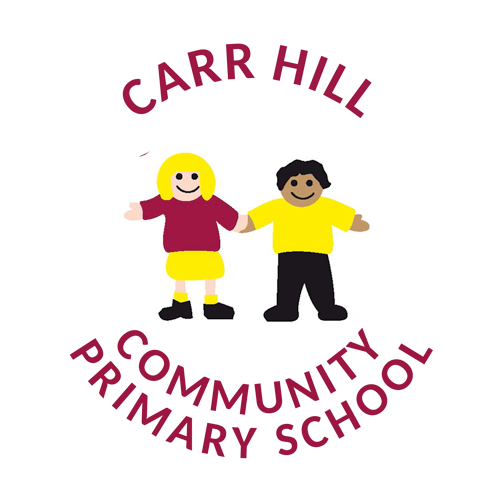Mrs Edge leads the teaching of Art and Design in School
Our Intent for Art and Design
At Carr Hill Community Primary School, we believe that high-quality Art lessons will engage and inspire children to think innovatively and develop creative understanding. Our Art curriculum provides children with opportunities to develop their skills using a range of media and materials. Children learn the skills of drawing, painting, printing, collage, textiles, 3D work and digital art and are given the opportunity to explore and evaluate different creative ideas. Children will be introduced to a range of works and develop knowledge of the styles and vocabulary used by famous artists. It is paramount that artwork be purposeful; be this as a means of expression or to explore the styles of other artists that inspire our own work. Pupils should be clear what the intended outcomes are and have a means to measure their own work against this. In Art, children are expected to be reflective and evaluate their work, thinking about how they can make changes and keep improving. This should be meaningful and continuous throughout the process, with evidence of age-related verbal and written refection. Children are encouraged to take risks and experiment and then reflect on why some ideas and techniques are successful or not for a particular project.
Our school focuses on developing key skills as set out in our progressive Art scheme of work. Throughout their time at school, children develop their artistic skills in 6 key areas: drawing, painting, collage, 3D form, print and textiles, ensuring they cover a range of these in each year group. Details of topics covered in each year group can be found on the art curriculum area of our school website.
As part of this planning process, teachers need to plan and use the following:
- The vocabulary overview sheets within each key area and these must be displayed at the start of the unit within their Sketch book.
- Vocabulary booklet, alongside images to assist children’s expansion of language.
- A cycle of lessons for each subject, which carefully plans for progression and depth from the medium term plans.
- Evidence of each of the 6 key areas of art across the two year cycle.
- Trips and visiting experts who will enhance the learning experience;
- A means to display and celebrate the pupils’ artwork in their class.
Throughout their time at school, children will develop these key skills set out by the national curriculum aims. These are as follows:
- produce creative work, exploring their ideas and recording their experiences
- become proficient in drawing, painting, sculpture and other art, craft and design techniques
- evaluate and analyse creative works using the language of art, craft and design
- know about great artists, craft makers and designers, and understand the historical and cultural development of their art forms.
Key stage 1
Pupils should be taught:
- to use a range of materials creatively to design and make products
- to use drawing, painting and sculpture to develop and share their ideas, experiences and imagination
- to develop a wide range of art and design techniques in using colour, pattern, texture, line, shape, form and space about the work of a range of artists, craft makers and designers, describing the differences and similarities between different practices and disciplines, and making links to their own work.
Key stage 2
- Pupils should be taught to develop their techniques, including their control and their use of materials, with creativity, experimentation and an increasing awareness of different kinds of art, craft and design.
- Pupils should be taught:
- to create sketch books to record their observations and use them to review and revisit ideas
- to improve their mastery of art and design techniques, including drawing, painting and sculpture with a range of materials [for example, pencil, charcoal, paint, clay]
- about great artists, architects and designers in history.
We also use pupil voice to measure and monitor the impact of the art curriculum on pupils, alongside traffic light on the key.
Purpose of study
Art, craft and design embody some of the highest forms of human creativity. A high-quality art and design education should engage, inspire and challenge pupils, equipping them with the knowledge and skills to experiment, invent and create their own works of art, craft and design. As pupils progress, they should be able to think critically and develop a more rigorous understanding of art and design. They should also know how art and design both reflect and shape our history, and contribute to the culture, creativity and wealth of our nation.
Below are links to Carr Hill’s knowledge progression steps for each year group:
Aims
The national curriculum for art and design aims to ensure that all pupils:
- produce creative work, exploring their ideas and recording their experiences
- become proficient in drawing, painting, sculpture and other art, craft and design techniques
- evaluate and analyse creative works using the language of art, craft and design
- know about great artists, craft makers and designers, and understand the historical and cultural development of their art forms.
Key stage 1
Pupils should be taught:
- use a range of materials creatively to design and make products
- to use drawing, painting and sculpture to develop and share their ideas, experiences and imagination
- to develop a wide range of art and design techniques in using colour, pattern, texture, line, shape, form and space
- about the work of a range of artists, craft makers and designers, describing the differences and similarities between different practices and disciplines, and making links to their own work.
Key stage 2
Pupils should be taught to develop their techniques, including their control and their use of materials, with creativity, experimentation and an increasing awareness of different kinds of art, craft and design.
Pupils should be taught:
- to create sketch books to record their observations and use them to review and revisit ideas
- to improve their mastery of art and design techniques, including drawing, painting and sculpture with a range of materials [for example, pencil, charcoal, paint, clay]
- about great artists, architects and designers in history.

Key Stage One:
Lower Key Stage Two:
Upper Key Stage Two:
Art Vocabulary:

